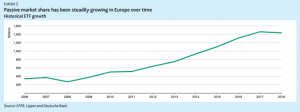Passive Investing to Overtake Active in 2021, Says Moody’s
Indexes now make up a bit more than one-third of funds, but will reach 50% in two years, the agency says.
A credit ratings agency is saying passive fund investing will overtake its actively managed cousin in two years.
Moody’s Investor Service said it is seeing more buying of index funds, a lot of it from outflow from active funds.
The reason for the outflows, the agency said, is that a passive strategy is cheaper for investors and creates “less leakage earnings.” The “leakage” comes from management fees, commissions, and trading costs to brokers, and the risk of poor investment decisions made by managers. All of which lands on the investors.
Last year, an estimated $369 billion was pulled from long-term mutual funds, according to research firm the Investment Company Institute.
The 2018 stock market volatility caused assets to crumble, but Moody’s said it theoretically should have “created more opportunities” for active managers to capitalize on downswings. Instead, it narrowed the gap in favor of index funds, which has steadily been widening since 2006.
“Prior to the downturn [in 2008], you were always hearing soundbites from the industry about how ‘you’re going to need active when the market goes down’ or ‘passive is just riding a bull market, and when the downturn comes, you’re going to see passive outflows,’” Steve Tu, Moody’s analyst who helped conduct the research, told CIO. “That narrative did not come to fruition.”
As of 2018, 36.7% of the US market accounts for passive investments. The firm decided 2021 will be the year investors in the US see index funds reaching 50%.
“That [2021] would be the crossover point for where the market share of passive increases to 50%,” Tu told CIO.
Other than pricing, a shift to passive investing has occurred due to more mergers and acquisitions occurring among funds, as well as an increased demand for more passive exchange-traded fund assets, or ETFs. As products that cater to the ETF industry grow, so does the value for passive shares.

The organization first noticed the growth momentum among index offerings in 2015, according to Brendan Mullin, the firm’s vice president. “To us, this is one of the biggest secular trends in the asset management industry,” he told CIO.
“The trend of active vs. passive is akin to the spread of the technology,” said Tu. “Others will say it’s based on some other dynamic. We view it as a more efficient technology. If it’s a better technology and more people that know about it, it’s going to spread over time.”
Moody’s also expects passive growth —and the ETF demand that goes with it— to spread further into Europe as regulations have made the strategy more attractive to retail investors. The European Union’s MIFID II rules last year provided more clarity on active fund fees, and also prevented funds from paying commissions to financial advisers. Currently, about 14.5% of the continent’s investors use index funds, but the credit agency said it will expand to 25% by 2025. Interest in the strategy has also been rapidly gaining traction since 2007.
“These changes will likely push retail investors toward cheaper passive funds, including ETFs, just as they become more widely available through investment online platforms,” the firm said. “European fund distribution has historically been dominated by banks that favor their own products, holding back take-up of ETFs relative to the US.”

Related Stories:
Will Index Funds Really Take Over the World?
Why Index Fund Creator Jack Bogle Hated ETFs
Moody’s Cautiously Upbeat on Brexit Extension
